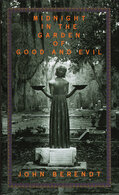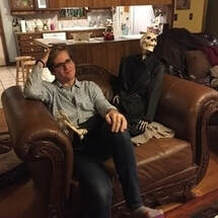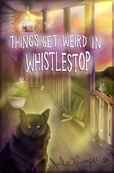 Midnight in the Garden of Good and Evil Author, Jon Berendt Review by Jarad Johnson Many of you will know the title of this book, a very popular book in the nineties. It was also made into a movie with John Cusack and Kevin Spacey - he adds a layer – but that’s not the point of this post. I was born at the end of the nineties and believe it or not I’d never heard of this book. Given that it’s an LGBTQ book, I’m surprised I missed it, but somehow, I did. I’m also not the most clued in about pop culture or the vile cesspools of social media. Although I consider myself very liberal and culturally aware, I also distance myself from certain things, which may be radical for someone my age. I just want you to understand that I had no, I repeat, no idea whatsoever what this book was about. No preconceptions. To tell you the truth, I recognized Bonaventure Cemetery from the cover; it’s one of the cemeteries I have always wanted to visit. That’s why I picked it up. I don’t know what I thought it would be about, but a murder trial was not it. This book dates itself in many ways, which is not necessarily a bad thing. Now, if this book was published today, I would tell you that it is a very surface level of what the, “gay community” is. A campy and very entertaining drag queen, a rich man who refuses to acknowledge that he’s gay, who holds fabulous dinner parties (clue number one!) and murders his younger lover. It sounds like the plot of a bad movie, and from the reviews I’ve read, that’s exactly the kind of movie that got made. I did not grow up with this image of the gay community as being a slew of casual sexual liaisons, drag balls and an almost anti-masculine culture -or hypermasculine, depending on where you were in the country. (If it explains anything, I grew up watching Will and Grace reruns and well as the Golden Girls when I was not reading fantasy novels and chasing butterflies in the back yard. And talking to cats and trees. I still do those things, but the conversations are a bit quieter.) Anyway, I never had this image of what, “being gay,” was. It was just a part of the person; it was not who they were in their entirety. So, it was a bit jarring for me to see these two-dimensional people, for whom being gay was the entirety of them – at least as far as this story was concerned. Society didn’t allow for any dimensions or context underneath being gay. There was certainly nothing wrong with any of the people in the book, their orientations or how they presented themselves – it just seems that the book never got underneath any of it to discover complexity. When a character was gay or trans, it seems that was the end of the exploration of their humanity. I think that’s probably how most of the world viewed being gay, and many still do. There’s this idea that being gay is separate from the rest of the world. It’s why it’s called a community-because it is inherently other from mainstream society. Well, I’ve got news for you. The “gay community,” is all around you. What we think of as gay culture may not everywhere around you, but gay people are, perhaps even the man you married! I kid, but if your husband dresses you, you have a stylist, not a husband (that’s a joke, by the way). And of course, it’s not bad to, “conform,” if you will, to these stereotypes of a gay man. I’m sure I conform to some of them. But I do think its bad if we force these stereotypes on people who don’t fit them or only see any given individuals as only the stereotypes and nothing else. Drag culture is central to this book, and it’s something I have been only tangentially interested in. I don’t dislike it, and in fact I have enjoyed many drag performances I have been to. I like the subversiveness of it, although with the advent of the reality show - something I don’t like as reality tv doesn’t seem terribly, you know…real - it’s arguably become mainstream, with its own rules and expectations of performativity. So, it’s not as subversive anymore, really. There are still drag queens who subvert the mainstream expectations, usually more comedic in nature, so I’m not dragging drag, just considering the differences between what it meant at the time this book was written versus now. The drag that was depicted in this book is what we would call now mainstream. It’s what you immediately think of when you think of drag. For the time period in this book, I would assume this was considered more taboo. The world has changed so much in the past twenty years that it feels like a different century, in terms of how people thought and acted. The also depicted a transgender woman, which for the time I assume was not something people talked about. I went back and read some reviews of the book at the time, and while they were all very positive, most did not mention the drag culture depicted there. Admittedly, I could find very few, but that is what I found. I guess Savannah wasn’t the only place where certain things were not spoken about. Savannah itself was almost a character in the book, depicted as typically southern. It was almost like walking into Gone with the Wind, without the false depiction of contented and happy slaves. The book left the reader with the feeling that everyone in Savannah was living behind some sort of façade, in true gothic tradition. Also, in true southern fashion, no conflict seems to permeate the lavish dinner parties. In the south, all petty arguments must be set aside when it’s time for hors d’oeuvres and cocktails. The whole book portrays an elaborate edifice with layers of deceit behind it, come to think of it. As the story unfolds, the outer layers of glitz and southern charm and inviting southern accents reveals the true character of the people depicted here. In that way, it’s fascinating, if superficial. I did enjoy the depiction of the root worker going into the cemetery in the middle of the night to put a curse on the judge presiding over the trial. I suppose the moral of that plot line is never piss off someone who knows their way around a cemetery. If you believe in the star rating system, I’d give this book a three. It was fine; not what I expected, but it was a good story, although it didn’t feel current. It was very thought provoking for me though, which I appreciate. It’s a look into the world as it was, which was full of stereotypes. If you haven’t read it, I think you should, if only to see how what the perception of the, “gay community,” was and maybe still is for some. And if you like true crime, of course you should read it. It was based on a true story and that’s fascinating in itself.  Bio: Jarad recently graduated from college at MTSU, loves tea and coffee, and tries to spend every spare second reading. He has been a fervent gardener for 6 years and is fascinated by all related topics and has spent the last several years writing about this passion. He believes that nature is our greatest teacher. He majored in English with a concentration in literature and plans to pursue and master’s degree in Ecocriticism.
4 Comments
Roy
3/18/2021 01:41:42 pm
I read this book not long after it came out, before the film version which, in my eyes, was dull, too long, and didn't give one a sense of Savannah the way the book did. As a book based on a true story I liked the way it was written more like a novel than some of the cut and dry true crime books that came before it.
Reply
I felt the same way about the book versus the movie. I don't know why the movie just couldn't pull itself together. I did enjoy Lady Chablis acting as herself in the movie and I don't regret watching it, but it didn't do the story justice. I wonder if this would be a good time to remake the movie with the fresh perspective that Jarad discusses in the blog post. I suppose no one will ask me. Too bad! I'm full of good ideas!
Reply
anne goodrich
9/20/2022 07:42:54 am
I did not care for the tone of the comment "you may have married one!"
Reply
Leave a Reply. |

Click Photo above to buy ebook or paperback from Amazon.
Here's the link to Barnes and Noble Or order through your favorite independent bookstore! Categories
All
|
 RSS Feed
RSS Feed